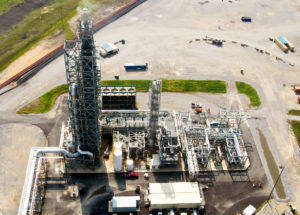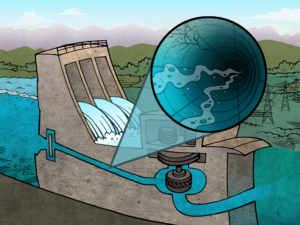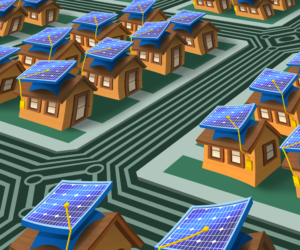Facts, Figures, and Findings from EPRI Research, Reports, and Other Sources

The Answer May Be ‘Yes’ in Some Cases, According to Retrofit Case Study in Alabama
Retrofitting some existing coal plants with partial post-combustion carbon capture may be competitive with newly constructed natural-gas–combined-cycle plants with respect to CO2 emissions and economics. This insight comes from an EPRI analysis of a partial capture retrofit of the 773-megawatt coal-fired Plant Barry Unit 5 operated by Southern Company subsidiary Alabama Power. The capture system used an amine-based solvent to absorb 45% of the CO2 from the plant’s flue gas, reducing total plant emissions to about 830 pounds per megawatt-hour. This is comparable to an ...
Read More
Retrofitting some existing coal plants with partial post-combustion carbon capture may be competitive with newly constructed natural-gas–combined-cycle plants with respect to CO2 emissions and economics. This insight comes from an EPRI analysis of a partial capture retrofit of the 773-megawatt coal-fired Plant Barry Unit 5 operated by Southern Company subsidiary Alabama Power. The capture system used an amine-based solvent to absorb 45% of the CO2 from the plant’s flue gas, reducing total plant emissions to about 830 pounds per megawatt-hour. This is comparable to an ...
Read More

EPRI Sizes Up Autonomous, Underwater Inspector-Bots
EPRI research sees significant potential to better inspect hydroelectric plants’ underwater structures with autonomous, untethered vehicles. Research also points to the need for additional technology development. A survey of government agencies, hydropower operators, utilities, and electric cooperatives identified the need for such vehicles to inspect tunnels and penstockspenstocks. This can replace the use of divers and help mitigate related safety hazards. Tethered vehicles today can travel only limited distances in hydro plants’ tunnels. To assess the state of the technology, researchers looked far afield, in oceanography, disaster recovery, oil and gas exploration, and other ...
Read More
EPRI research sees significant potential to better inspect hydroelectric plants’ underwater structures with autonomous, untethered vehicles. Research also points to the need for additional technology development. A survey of government agencies, hydropower operators, utilities, and electric cooperatives identified the need for such vehicles to inspect tunnels and penstockspenstocks. This can replace the use of divers and help mitigate related safety hazards. Tethered vehicles today can travel only limited distances in hydro plants’ tunnels. To assess the state of the technology, researchers looked far afield, in oceanography, disaster recovery, oil and gas exploration, and other ...
Read More

At Four Field Sites, EPRI Demonstrates Standard Grid-Support Functions and Communications
Working on distribution grids in Massachusetts and Michigan, EPRI, DTE Energy, Pepco Holdings, and National Grid successfully demonstrated standardized smart inverter grid-support functionsstandardized smart inverter grid-support functions and utility control of inverters using a standard communications protocolstandard communications protocol. These milestone field tests mark a key step toward enabling grid operators to manage high penetrations of solar photovoltaic (PV) generation, and they are the culmination of a four-year project under the U.S. Department of Energy (DOE) SunShot Initiative to develop, analyze, and test smart inverters in the lab and ...
Read More
Working on distribution grids in Massachusetts and Michigan, EPRI, DTE Energy, Pepco Holdings, and National Grid successfully demonstrated standardized smart inverter grid-support functionsstandardized smart inverter grid-support functions and utility control of inverters using a standard communications protocolstandard communications protocol. These milestone field tests mark a key step toward enabling grid operators to manage high penetrations of solar photovoltaic (PV) generation, and they are the culmination of a four-year project under the U.S. Department of Energy (DOE) SunShot Initiative to develop, analyze, and test smart inverters in the lab and ...
Read More

Utilities Can Learn from Netflix and Other Successful Companies
Using the data and analytics available today, utilities have the opportunity to transform their traditionally reactive customer call centers into business and information centers, according to EPRI research. For ideas and inspiration, utilities can look to companies in diverse industries that use customer analytics effectively. Netflix, for example, uses data on what, where, when, and how subscribers watch programming to personalize their viewing experience, and taps its vast database of user behavior to guide development of its original programming. For utility customer programs, automated analysis of demographic data, consumption history, and ...
Read More
Using the data and analytics available today, utilities have the opportunity to transform their traditionally reactive customer call centers into business and information centers, according to EPRI research. For ideas and inspiration, utilities can look to companies in diverse industries that use customer analytics effectively. Netflix, for example, uses data on what, where, when, and how subscribers watch programming to personalize their viewing experience, and taps its vast database of user behavior to guide development of its original programming. For utility customer programs, automated analysis of demographic data, consumption history, and ...
Read More

When EPRI combined atmospheric and watershed modeling to look at the fate of trace metal emissions across the San Juan River watershed, the research indicated that from 2020 to 2044, the coal-fired Navajo Generating Station will contribute less than 1% of mercury deposition, with 3% coming from all other North American sources (including local power plants), 16% from China, and 80% from the rest of the world. The watershed includes portions of Arizona, Utah, New Mexico, and Colorado, and the research confirms results of a similar EPRI study of the Four Corners Power Plant in New Mexico—which revealed the growing ...
Read More
Read More

